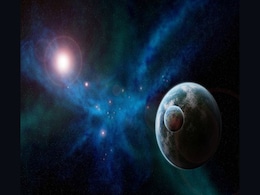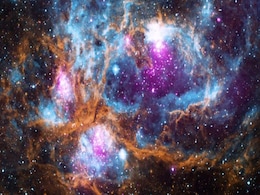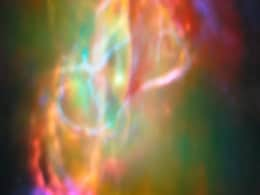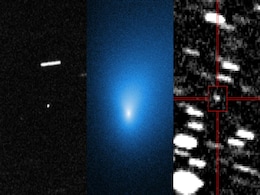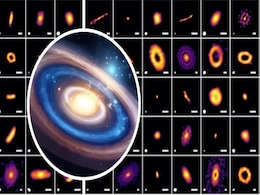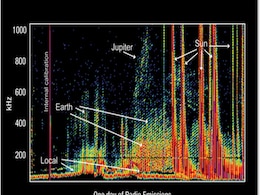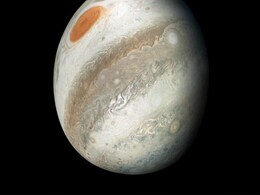Planet Near Star
- All
- News
-

Astronomers Spot First Coronal Mass Ejection from a Distant Star, Raising Questions About Planetary Habitability
- Monday November 17, 2025
Astronomers detected the first coronal mass ejection from a distant star, revealing that powerful stellar eruptions may strip atmospheres from nearby planets, affecting exoplanet habitability and the search for life.
-
 www.gadgets360.com
www.gadgets360.com
-

NASA's Astronomers Reveal Red Giant Stars May Destroy Their Own Planets
- Monday November 10, 2025
- Science |
This extreme expansion poses a serious threat to nearby planets. For example, when the Sun becomes a red giant in about 5 billion years, it will likely swallow Mercury and Venus.
-
 www.ndtv.com
www.ndtv.com
-

Could a Planet Exist Without a Host Star? Astronomers Say Rogue Worlds May Roam Freely
- Monday September 8, 2025
Astronomers have discovered that planets can survive without stars, drifting as rogue or hypervelocity worlds. Some are flung into space by black holes, while others are displaced by gas giants. On some of these rogue worlds, the idea goes, there might be oceans beneath icy crusts, where life, at least life at a microbe level, could exist.
-
 www.gadgets360.com
www.gadgets360.com
-

James Webb Spots Bizarre Planet-Forming Disk Full of Carbon Dioxide
- Friday September 5, 2025
The James Webb Space Telescope has spotted a bizarre planet-forming disk dominated by carbon dioxide where water is almost absent. This rare finding, in star system XUE 10 within NGC 6357, challenges current models of planetary formation and may reshape our understanding of habitable worlds.
-
 www.gadgets360.com
www.gadgets360.com
-

James Webb Space Telescope Spots Planet-Building Dust in the Butterfly Nebula
- Friday August 29, 2025
The James Webb Space Telescope has unveiled stunning new details of the Butterfly Nebula, a planetary nebula 3,400 light-years away. Using its infrared vision, Webb detected crystalline silicates, large dust grains, and carbon-rich PAH molecules within the nebula’s dusty torus. These discoveries reveal how dying stars recycle minerals and organic...
-
 www.gadgets360.com
www.gadgets360.com
-

Astronomers Discover 3I/ATLAS, Largest Interstellar Comet Yet Detected
- Sunday July 6, 2025
Astronomers have discovered 3I/ATLAS, the third known interstellar comet to pass through our solar system. Detected by the ATLAS telescope in Chile, it’s racing inward at 150,000 mph and will swing closest to the Sun in October. Estimated to be 10–20 kilometers across, it is likely the largest interstellar object observed so far. Signs of comet...
-
 www.gadgets360.com
www.gadgets360.com
-

Astronomers Discover Baby Planets Taking Their First Steps in Nearby Stellar Nursery
- Monday June 30, 2025
Astronomers have detected early signs of planet formation in 27 young protoplanetary disks within the Ophiuchus star-forming region, just 460 light-years away. High-resolution imaging revealed spiral and ring patterns forming earlier than expected, suggesting stars and planets may grow together from infancy. The findings bridge a knowledge gap betw...
-
 www.gadgets360.com
www.gadgets360.com
-

Quantum Tech Could Finally Let Astronomers Snap Direct Images of Earth-Like Exoplanets
- Tuesday May 27, 2025
Astronomers are harnessing quantum mechanics to build a coronagraph that could directly image Earth-like exoplanets previously obscured by stellar glare. By sorting light waves at the photon level, the device bypasses traditional diffraction limits, revealing faint planetary signals. This breakthrough may redefine how scientists explore distant wor...
-
 www.gadgets360.com
www.gadgets360.com
-

Hubble Telescope Finds Unexpectedly Hot Accretion Disk in FU Orionis
- Friday November 22, 2024
Hubble Space Telescope’s recent observations of FU Orionis have revealed surprising new details about the star’s accretion disk. The study found that the disk’s inner edge reaches temperatures as high as 16,000K, nearly three times hotter than the Sun’s surface. This discovery challenges existing models of stellar accretion, which had predi...
-
 www.gadgets360.com
www.gadgets360.com
-

Scientists Scan TRAPPIST-1 for Interplanetary Radio Signal Using Allen Telescope Array
- Friday October 18, 2024
Scientists at Penn State and the SETI Institute have developed a new method to search for interplanetary radio signals from planets in the TRAPPIST-1 system. Using the Allen Telescope Array, they scanned this system for nearly 28 hours but did not find evidence of alien communication. This project, however, has introduced a new way of detecting pot...
-
 www.gadgets360.com
www.gadgets360.com
-

Jupiter Has An Identical Twin, 17,000 Light-Years Away
- Monday April 4, 2022
- World News |
Astronomers have discovered a planet that is nearly identical to Jupiter, circling a star 17,000 light-years away from the Earth.
-
 www.ndtv.com
www.ndtv.com
-

Can Dying Stars Give Birth to New Planets? Here’s What Scientists Have to Say
- Monday February 7, 2022
- Edited by Gadgets 360 Newsdesk
Scientists now say it is not necessarily the only possibility. They say planets can form even if a star is nearing its death, long after the star was formed. Dying stars leading to the formation of planets is a completely new theory. If confirmed, this finding can change how we understand the functions of the universe and planetary evolution.
-
 www.gadgets360.com
www.gadgets360.com
-

Scientists Find 'Largest Cluster' of Nearly 100 Free-Floating Planets in a Single Star-Forming Region
- Monday December 27, 2021
- Edited by Gadgets 360 Newsdesk
Rogue planets have baffled astronomers for ages. Unlike regular planets which revolve around stars, these free-floating planets (FFPs) get ejected from star systems to move about in the galaxy on their own. In the latest discovery, astronomers found the largest cluster of rogue planets in a single star-forming region.
-
 www.gadgets360.com
www.gadgets360.com
-

How Close Will Jupiter, Saturn Come Today In About 400 Years? See Here
- Monday December 21, 2020
- India News | Edited by Debjani Chatterjee
Great Conjunction: The Jupiter and Saturn appear to pass each other nearly once every 20 years but what is so extraordinary about today's celestial extravaganza? The NASA says, "It's been nearly 400 years since the planets passed this close to each other in the sky'.
-
 www.ndtv.com
www.ndtv.com
-

Astronomers Spot First Coronal Mass Ejection from a Distant Star, Raising Questions About Planetary Habitability
- Monday November 17, 2025
Astronomers detected the first coronal mass ejection from a distant star, revealing that powerful stellar eruptions may strip atmospheres from nearby planets, affecting exoplanet habitability and the search for life.
-
 www.gadgets360.com
www.gadgets360.com
-

NASA's Astronomers Reveal Red Giant Stars May Destroy Their Own Planets
- Monday November 10, 2025
- Science |
This extreme expansion poses a serious threat to nearby planets. For example, when the Sun becomes a red giant in about 5 billion years, it will likely swallow Mercury and Venus.
-
 www.ndtv.com
www.ndtv.com
-

Could a Planet Exist Without a Host Star? Astronomers Say Rogue Worlds May Roam Freely
- Monday September 8, 2025
Astronomers have discovered that planets can survive without stars, drifting as rogue or hypervelocity worlds. Some are flung into space by black holes, while others are displaced by gas giants. On some of these rogue worlds, the idea goes, there might be oceans beneath icy crusts, where life, at least life at a microbe level, could exist.
-
 www.gadgets360.com
www.gadgets360.com
-

James Webb Spots Bizarre Planet-Forming Disk Full of Carbon Dioxide
- Friday September 5, 2025
The James Webb Space Telescope has spotted a bizarre planet-forming disk dominated by carbon dioxide where water is almost absent. This rare finding, in star system XUE 10 within NGC 6357, challenges current models of planetary formation and may reshape our understanding of habitable worlds.
-
 www.gadgets360.com
www.gadgets360.com
-

James Webb Space Telescope Spots Planet-Building Dust in the Butterfly Nebula
- Friday August 29, 2025
The James Webb Space Telescope has unveiled stunning new details of the Butterfly Nebula, a planetary nebula 3,400 light-years away. Using its infrared vision, Webb detected crystalline silicates, large dust grains, and carbon-rich PAH molecules within the nebula’s dusty torus. These discoveries reveal how dying stars recycle minerals and organic...
-
 www.gadgets360.com
www.gadgets360.com
-

Astronomers Discover 3I/ATLAS, Largest Interstellar Comet Yet Detected
- Sunday July 6, 2025
Astronomers have discovered 3I/ATLAS, the third known interstellar comet to pass through our solar system. Detected by the ATLAS telescope in Chile, it’s racing inward at 150,000 mph and will swing closest to the Sun in October. Estimated to be 10–20 kilometers across, it is likely the largest interstellar object observed so far. Signs of comet...
-
 www.gadgets360.com
www.gadgets360.com
-

Astronomers Discover Baby Planets Taking Their First Steps in Nearby Stellar Nursery
- Monday June 30, 2025
Astronomers have detected early signs of planet formation in 27 young protoplanetary disks within the Ophiuchus star-forming region, just 460 light-years away. High-resolution imaging revealed spiral and ring patterns forming earlier than expected, suggesting stars and planets may grow together from infancy. The findings bridge a knowledge gap betw...
-
 www.gadgets360.com
www.gadgets360.com
-

Quantum Tech Could Finally Let Astronomers Snap Direct Images of Earth-Like Exoplanets
- Tuesday May 27, 2025
Astronomers are harnessing quantum mechanics to build a coronagraph that could directly image Earth-like exoplanets previously obscured by stellar glare. By sorting light waves at the photon level, the device bypasses traditional diffraction limits, revealing faint planetary signals. This breakthrough may redefine how scientists explore distant wor...
-
 www.gadgets360.com
www.gadgets360.com
-

Hubble Telescope Finds Unexpectedly Hot Accretion Disk in FU Orionis
- Friday November 22, 2024
Hubble Space Telescope’s recent observations of FU Orionis have revealed surprising new details about the star’s accretion disk. The study found that the disk’s inner edge reaches temperatures as high as 16,000K, nearly three times hotter than the Sun’s surface. This discovery challenges existing models of stellar accretion, which had predi...
-
 www.gadgets360.com
www.gadgets360.com
-

Scientists Scan TRAPPIST-1 for Interplanetary Radio Signal Using Allen Telescope Array
- Friday October 18, 2024
Scientists at Penn State and the SETI Institute have developed a new method to search for interplanetary radio signals from planets in the TRAPPIST-1 system. Using the Allen Telescope Array, they scanned this system for nearly 28 hours but did not find evidence of alien communication. This project, however, has introduced a new way of detecting pot...
-
 www.gadgets360.com
www.gadgets360.com
-

Jupiter Has An Identical Twin, 17,000 Light-Years Away
- Monday April 4, 2022
- World News |
Astronomers have discovered a planet that is nearly identical to Jupiter, circling a star 17,000 light-years away from the Earth.
-
 www.ndtv.com
www.ndtv.com
-

Can Dying Stars Give Birth to New Planets? Here’s What Scientists Have to Say
- Monday February 7, 2022
- Edited by Gadgets 360 Newsdesk
Scientists now say it is not necessarily the only possibility. They say planets can form even if a star is nearing its death, long after the star was formed. Dying stars leading to the formation of planets is a completely new theory. If confirmed, this finding can change how we understand the functions of the universe and planetary evolution.
-
 www.gadgets360.com
www.gadgets360.com
-

Scientists Find 'Largest Cluster' of Nearly 100 Free-Floating Planets in a Single Star-Forming Region
- Monday December 27, 2021
- Edited by Gadgets 360 Newsdesk
Rogue planets have baffled astronomers for ages. Unlike regular planets which revolve around stars, these free-floating planets (FFPs) get ejected from star systems to move about in the galaxy on their own. In the latest discovery, astronomers found the largest cluster of rogue planets in a single star-forming region.
-
 www.gadgets360.com
www.gadgets360.com
-

How Close Will Jupiter, Saturn Come Today In About 400 Years? See Here
- Monday December 21, 2020
- India News | Edited by Debjani Chatterjee
Great Conjunction: The Jupiter and Saturn appear to pass each other nearly once every 20 years but what is so extraordinary about today's celestial extravaganza? The NASA says, "It's been nearly 400 years since the planets passed this close to each other in the sky'.
-
 www.ndtv.com
www.ndtv.com



